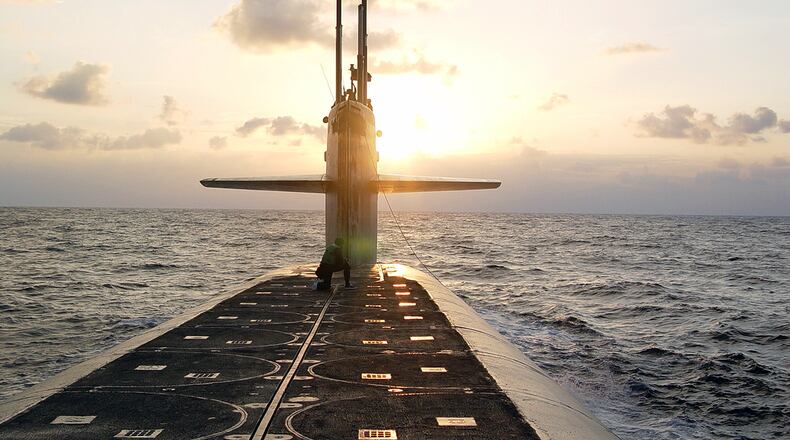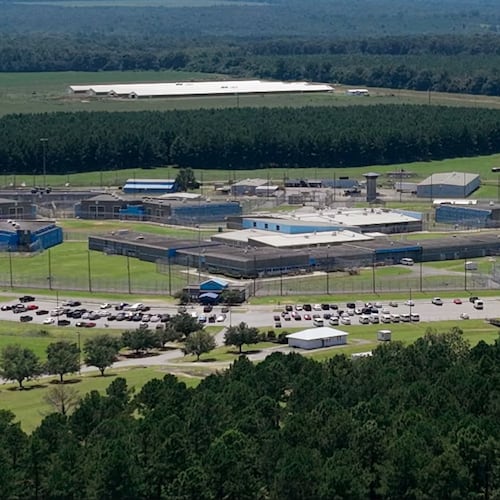Georgia’s Naval Submarine Base Kings Bay recently deployed a new type of nuclear warhead aboard one of its submarines, according to a respected independent monitor, renewing debate about the U.S. strategy for preventing nuclear war with would-be adversaries.
The Federation of American Scientists, a Washington think tank that aims to reduce the spread of nuclear weapons, reported Wednesday that one of the base's Ohio-class ballistic missile submarines, the USS Tennessee, went on patrol in late 2019 with "one or two" of the new weapons, known as W76-2.
The W76-2 is what’s known as a “low-yield” nuclear warhead. It’s about one-third the size of the atomic bomb U.S. forces dropped on Hiroshima in 1945 and is said to have roughly 5% the explosive power of the nuclear warheads the Navy carries on many of its other submarines.
Supporters see the W76-2 as an effective nuclear deterrence method, particularly against Russia, which the Trump administration believes has been eyeing similar technology as it’s grown its weapons stockpile.
Opponents say the warhead is at best unnecessary — the U.S. already has low-yield options it can launch from the air — and at worst could lead to rapid nuclear escalation and mass death and destruction.
Hans Kristensen, director of the Federation of American Scientists’s Nuclear Information Project, said he learned of the W76-2 deployment from federal officials and believes the USS Tennessee is still deployed in the Atlantic.
“They go out there and hide and are supposed to be available to the National Command Authority in case something goes really, really wrong,” said Kristensen, who added that a second ballistic missile submarine with the technology may be patrolling in the Pacific.
The Pentagon would not confirm the report from the Federation, which was started in 1946 by scientists who helped develop the atom bomb as part of the U.S. government’s Manhattan Project.
“It is U.S. policy to neither confirm nor deny the presence or absence of nuclear weapons at any general or specific location. As such we cannot confirm or deny this reporting at this time,” the Department of Defense said in a statement.
The base at Kings Bay did not respond to a request for comment. It is located next to St. Marys on Georgia’s southeast coast.
The W76-2 was first pitched by the Trump administration less than two years ago. The White House believes Russia could use a lower-yield nuclear weapon to try and scare the U.S. or NATO allies into ending a conflict, the thought being that the U.S. may hesitate to use a bigger bomb that could level cities and prompt a full-blown nuclear war.
Developing a smaller American warhead for its submarines would "help counter any mistaken perception of an exploitable 'gap' in U.S. regional deterrence capabilities," the Defense Department wrote in a February 2018 report.
Franklin C. Miller, a principal at the Scowcroft Group who spent more than three decades working on defense policy at the Pentagon and White House, said “deterrence is all about what the other guy thinks. Not what we think.”
“We’re trying to tell the Russian leadership you can’t use a nuclear weapon with impunity,” he said.
House Democrats tried but ultimately failed to block funding for the weapon on Capitol Hill. The Federation of American Scientists suspects about 50 have been produced since then and has been critical of the need for them. Kristensen and others have warned about smaller warheads making nuclear weapons seem more acceptable to the military during conflicts.
Another skeptic has been former U.S. Sen. Sam Nunn, D-Ga. The ex-Armed Services Committee Chairman, who co-authored a 1991 agreement that helped dismantle thousands of nuclear weapons after the fall of the Soviet Union, called even low-yield warheads “very high-risk.”
It “gives me concern that we’re signaling, perhaps inadvertently, that we can actually have a low-yield warhead war without escalating to Armageddon,” said Nunn, who after his retirement from Congress founded a non-proliferation-focused nonprofit, the Nuclear Threat Initiative.
“Once you start using nuclear weapons I think there will be escalation right up the ladder,” Nunn added.
Kings Bay is the Navy’s East Coast home for its Ohio-class ballistic missile submarines. Six are stationed there and another eight are in Bangor, Wash.
The base hosts more than 1,000 enlisted and civilian government workers and their families and was the site of a dramatic break-in by seven Catholic activists in 2018.
U.S. Sen. David Perdue, R-Ga., who leads the Senate Armed Services Subcommittee that oversees the Navy, declined to comment on the W76-2 but said he’s “proud to support Kings Bay in the U.S. Senate and believe(s) maintaining a robust nuclear deterrent is critical to U.S. national security.”
About the Author
Keep Reading
The Latest
Featured



